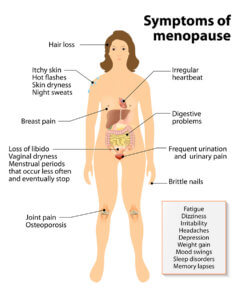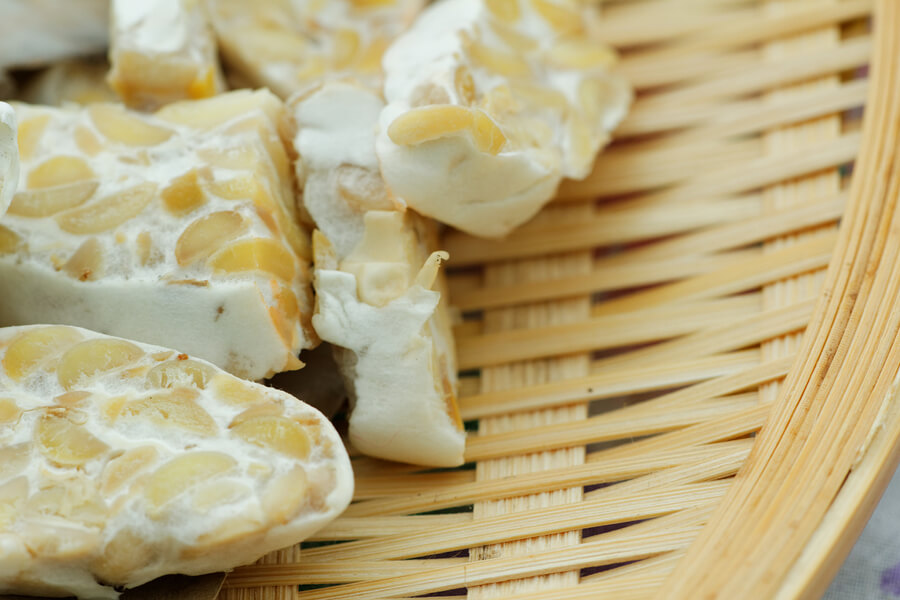Phytoestrogens are chemicals in plants. When they are consumed, they mimic the effect of estrogens in the human body.
As a woman goes through menopause, her body produces increasingly less estrogen and progesterone. This decrease in female hormones often causes many problems.
Hot flashes, mood swings, and night sweats are very common problems.
Other issues are vaginal dryness, labial itching, insomnia, anxiety, and depression.
Vaginal dryness causes discomfort during sexual intercourse.
Memory fog, heart palpitations, and brittle bones are also on the list of menopause issues.
Many women report a tremendous easing of these symptoms by adding more phytoestrogens to their diet.
In fact, phytoestrogens eliminate these life disrupting symptoms for many women.
What are phytoestrogens?
Phytoestrogens are sometimes called “dietary estrogens” or “xenoestrogens”. They are not produced internally by the endocrine system.
They are obtained by eating phytoestrogen rich foods or taking phytoestrogens supplements. Chemically, they are not identical to estrogen but they are very similar in structure.
There are four primary classes of phytoestrogens: isoflavones, lignans, flavones and coumestans.
They consist of aromatic rings of carbon atoms bonded to hydroxyl groups. A hydroxyl group contains an oxygen atom bonded to a hydrogen atom.
Phenols that work as phytoestrogens are able to bind to the same receptors as estrogen. Thus, working the same magic!
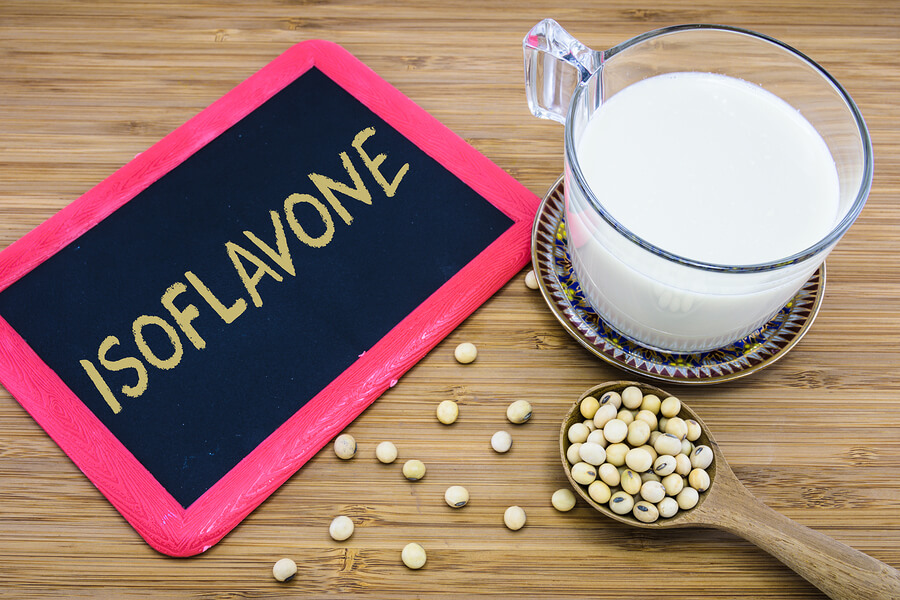
The three most common isoflavones are daidzein, genistein, and glycitin.
Lignans are found most abundantly in nuts, seeds, and grains. We are talking about real grains like wheat and rye, not pseudo-grains like quinoa.
The primary flavone that mimics estrogen is luteolin. This phytoestrogen is high in most green herbs. Luteolin is especially high in parsley, peppermint, basil, and thyme.
It is also abundant in black pepper, celery, bell peppers, broccoli, apples, blackberries, and blueberries.
Coumestans are especially high in alfalfa sprouts and clover sprouts. But, they are also found in all legumes.
Hormone replacement therapy versus phytoestrogen-rich foods
Traditional doctors often prescribe hormone replacement therapy (HRT) for menopausal women. Unfortunately, this type of therapy can do far more harm than it does good!
It can put you at a much higher risk for many health issues or conditions. It can increase your risk for cardiovascular diseases. The risk of heart attack, hypertension, blood clot, stroke and high triglycerides is greater.
HRT can also increase the risk of breast cancer, gall bladder and liver disease, and dementia.
Additionally, getting the dosing right can be very difficult. This can cause a jolt to the system and wildly fluctuating side effects in the process.
Most woman taking hormone replacement therapy experience one or more side effects. These are headaches, fluid retention, sore breasts, hair loss, and vaginal yeast infections.
Consuming phytoestrogen rich foods is a MUCH gentler approach than hormone replacement therapy.
Another alternative is to take phytoestrogens supplements.
One of the benefits is that there is no jolt to your system by increasing phytoestrogens.
Furthermore, they do not cause the side effects that women so often get with hormone replacement therapy.
Moreover, phytoestrogens are better at reducing menopausal symptoms. They actually reduce many of the side effects that hormone replacement therapy causes. For example, phytoestrogens are very good for the cardiovascular system.
How to get more phytoestrogens into your diet?
Nuts and seeds
All nuts and seeds contain good amounts of phytoestrogens. But, flax seeds and sesame seeds are particularly high in phytoestrogens.
Of the commonly eaten nuts, walnuts contain the most phytoestrogens. Put this information to good use.
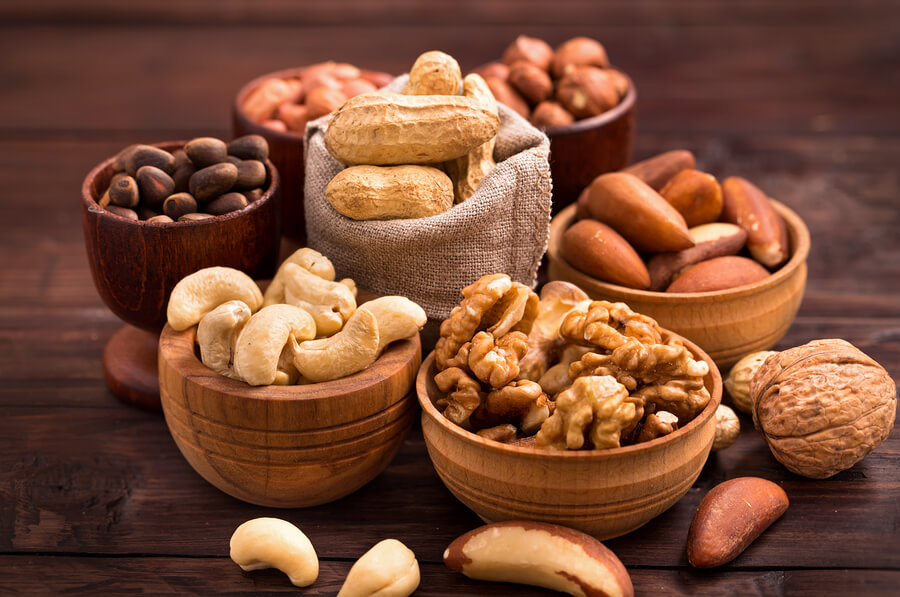
There's nothing wrong with loading up your homemade brownies with extra walnuts.
When you eat corn chips with salsa, pick the organic corn chips with flax seeds.
Luckily, nuts are natural ingredients that you can buy in bulk. They add delicious flavor and more protein to many types of prepared meals. On the list are cereals, oatmeal, salads, stir fries, and spreads for bagels, crackers, and toasts.
They are also a convenient snack. You can take them to work or on trips to simply munch on when you get hungry. Or when you feel your hormones beginning to fluctuate.
Soy products
Soy products are another great way to get more phytoestrogens into your diet. Most people immediately think of tofu when they hear the word “soy”.
There are many other forms of delicious soy products you can enjoy (see below). Liquid soy can be used to make salad dressings and sauces. Or used as a mayonnaise substitute in dishes like potato salad or chicken salad.
Tempeh is a fermented soy bean product that has lots of good texture. It tastes great pan fried and or steamed.
You can serve it with vegetables over a bed of rice, noodles, or quinoa.
If you buy extra firm tempeh, you can brown it in a pan. Chop it up as you would ground beef.
Once you've made this base, you can make any dish you would normally make with ground beef.
You can make a quick spaghetti sauce, slowed cooked chili, or many stove top casserole dishes.
Tempeh is also sometimes used as a tasty cheese substitute on sandwiches or in salads.
Some people marinade tempeh just as they would strips of meat. You can cook it in stir fries with vegetables.
Basically, tempeh is so versatile and tasty. Hearty meat eaters often end up loving it.
Soy milk is an easy option to get more phytoestrogens into your diet since you can simply add it to coffee and tea.
You can also use soy milk to make other delicious hot drinks like cafe latte, spicy chai, and hot chocolate.
You can add soy milk to scrambled eggs before you cook them, just as you would do with dairy milk. Soy milk is also great in other favorite breakfast foods.
Breakfast smoothies, granola, cream of wheat, creamy grits, and pancakes are one of them. Soy based yogurts have also become very popular.
A note on soy products
Dr. Axe is not an advocate of soy products. He recommends the removal of all soy milk, soy protein and most other forms of soy.
In fact, most soy in the USA is genetically modified and should be avoided. This type of soy weeds out the good bacteria in your gut.
Dr. Axe recommends the use of fermented soy, especially soy lecithin. Unfermented soy should be avoided.
Soy is high in phytoestrogens. Therefore, soy will give more feminine characteristics to a male consuming extra estrogen.
Herbal teas
Drinking herbal teas is another easy way to add phytoestrogens to your diet. Black cohosh, dong quai, licorice, and anise are popular herbs known to ease menopausal symptoms.
There are also red clover, evening primrose, chaste tree berry, ginkgo, and ginseng. Clover is a legume like soy.
These herbs are also common ingredients in natural phytoestrogens supplements. They are designed to help ease menopause symptoms.
Taking supplements containing these herbs could become a morning and/or an evening ritual. It is probably the most convenient way to to ensure you get enough phytoestrogens into you diet to truly make a difference.
Vegetables and fruits
Increasing vegetables and fruits in your diet will provide more healthy phytoestrogens. You should make an effort to eat every color of the rainbow.
Yams, broccoli, apples, carrots, fennel, and pomegranate all contain good amounts of phytoestrogens.
Oats, wheat, rye, and barley contain good amounts of phytoestrogens too. Try making bean soups with a mixture of a variety of beans. The beans themselves will give good doses of phytoestrogens.
You can also add in celery, onion, and greens to give more variety of estrogens. Try roasting beets, turnips, and parsnips along with red potatoes!
If you eat more whole foods and less processed foods, you'll get more phytoestrogens too.
Brown rice has more phytoestrogens than white rice. This is because they are concentrated in the bran of the rice. Slow cooking oats, like steel cut oats, have more phytoestrogens than instant oats.
Make your own hummus. But leave the outer peel of the chickpeas on. There are more phytoestrogens in the peel. If you buy pre-made hummus, the outer peel is usually removed.
Eat fruit with the peel instead of buying fruit juices or jams. These latter lack the peel.
Dried apricots and prunes (plums) contain more phytoestrogens than many processed fruit products. The peel of these dried fruits was left on. If you eat a raw apple, don't peel it.
Research on using phytoestrogens to lessen menopausal symptoms
Since 2002, hundreds of well-designed research studies have proven the effectiveness of phytoestrogens. These studies showed a significant reduction of the worst symptoms of menopause.
Additionally, there have been several review papers published in the scientific literature.
They discuss and summarize the positive effect of phytoestrogens on alleviating menopausal symptoms.
Phytoestrogens reduce the symptoms of menopause. It's done without the harmful side effects of hormone replacement therapy.
They work well to smooth out the menopause symptoms.
This is well documented and proven. Some doctors are now recommending dietary changes instead of hormone replacement therapy.
But, the pharmaceutical industry continues to push hormone replacement therapy. It encourages doctors (starting in medical school) to prescribe it.
Few studies have reached the opposite conclusion about the use of phytoestrogens. Interestingly, they were largely funded by the pharmaceutical industry.
The importance of probiotics and prebiotics
To get the full benefit from phytoestrogens, you must have a well balanced gut flora. The symbiotic bacteria in your intestines make them more bioavailable.
Thus, you should increase both probiotics and prebiotics in your diet. This helps whether you are taking phytoestrogen supplements and/or phytoestrogen rich foods.
Many people turn to yogurt as their primary source of probiotics. But, American yogurts usually only have two to five strains of beneficial bacteria.
Eating lacto-fermented vegetables will actually get you a much higher diversity of probiotics. This will enhance the action of the phytoestrogens you consume.
These lacto-fermented vegetables include traditionally prepared kim chi, sauerkraut, pickles (cucumbers) and carrots. You can also find delicious lacto-fermented daikon radish, turnips, chard, and green tomatoes.
Lacto-fermented cauliflower, green beans, bell pepper, garlic, and onions are also recommended.
Lacto-fermented fruits are becoming increasingly popular. Among these are lacto-fermented apple chutney or lacto fermented cherries.
Prebiotics are nondigestible food ingrediens. They feed your friendly symbiotic gut bacteria. By doing so, they help them flourish. Prebiotics also help your good gut bacteria out-compete the bad gut bacteria.
This latter can actually prevent assimilation of phytoestrogens. Bad gut bacteria can slow your absorption of the nutrients you need during menopause.
Some of the best prebiotics are inulin and fructooligosaccharides (FOS). Foods high in these include jícama (very high), bananas, and onions. Other foods in this category are garlic, leeks, shallots, asparagus, and chicory root.
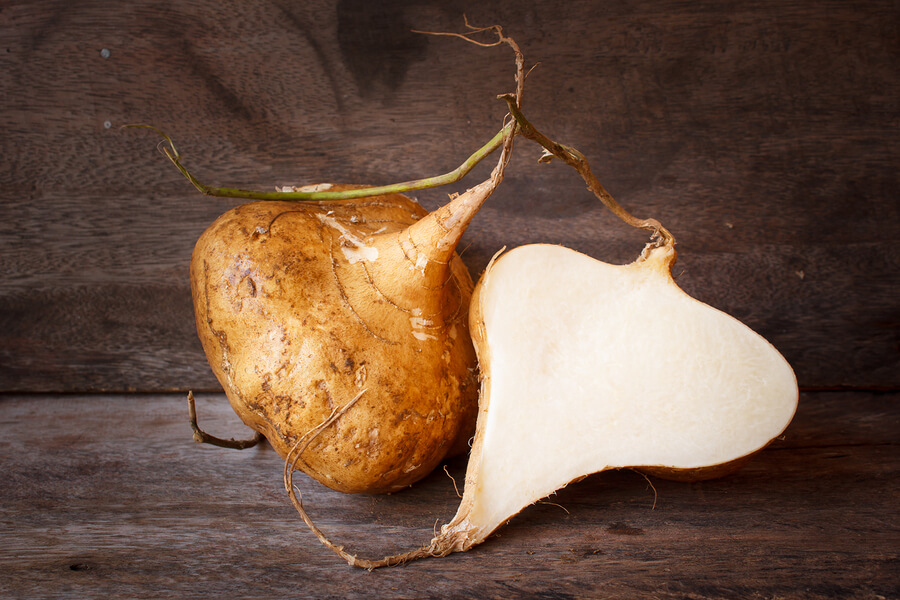
Jicama
Yacon syrup is extremely high in inulin and fructooligosaccharides. It is an excellent way to add sweetness without adding too many calories. Be sure to get it raw.
Conclusion
Menopause can cause a great deal of grief in a woman's life. The physical symptoms are difficult to deal with.
Moreover, having to adjust to menopause causes anxiety. This can put a great deal of strain on relationships. Menopause can even make it difficult to perform at work.
Hormone replacement therapy carries with it too many health risks. It usually doesn't work very well. It can cause a jolt to the system.
Adding phytoestrogens to your diet, along with probiotics and prebiotics, is very beneficial. It can ease menopausal symptoms without the side effects of hormone replacement therapy.
This can be accomplished through a combination of dietary changes and natural phytoestrogens supplements.
In fact, this is the secret to going through menopause relatively symptom-free for many woman.
And stress-free too!
Now, we've let you in on the secret.
